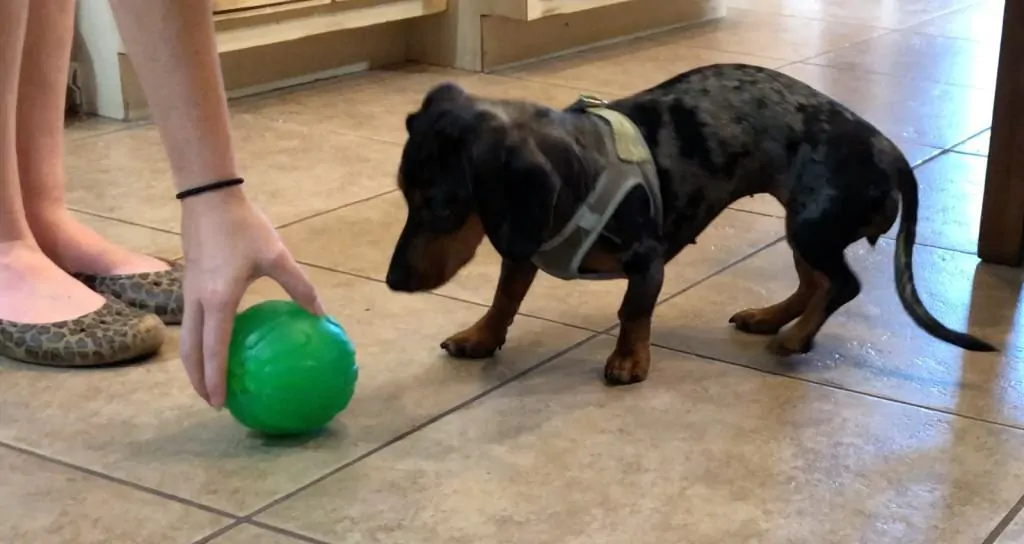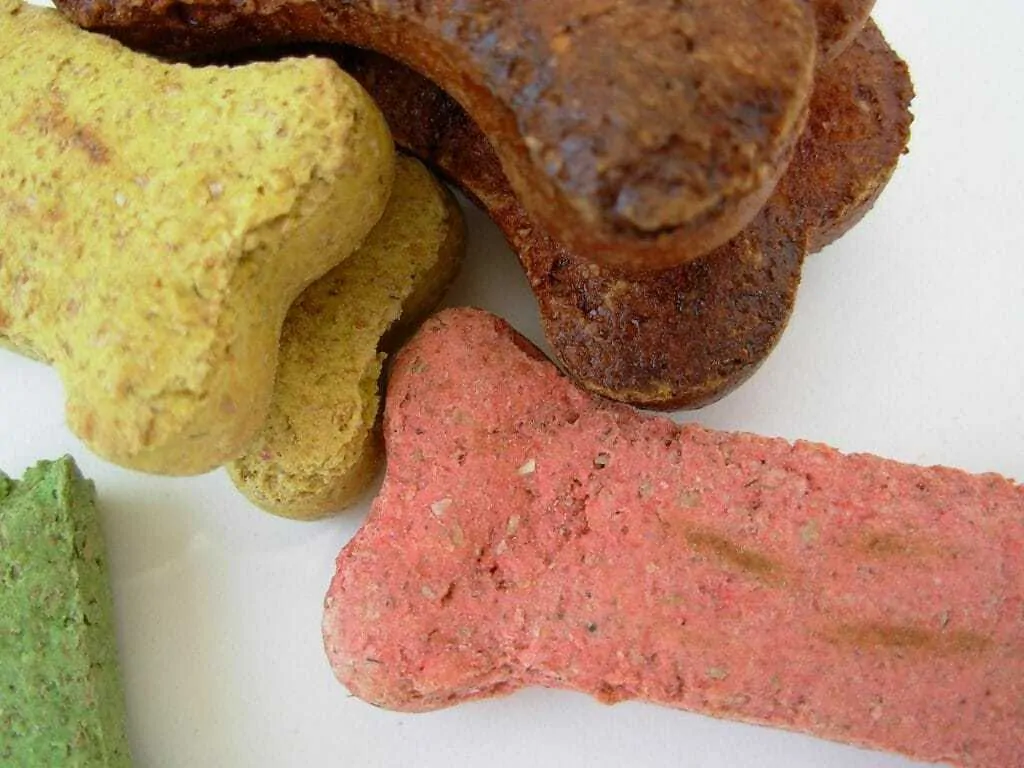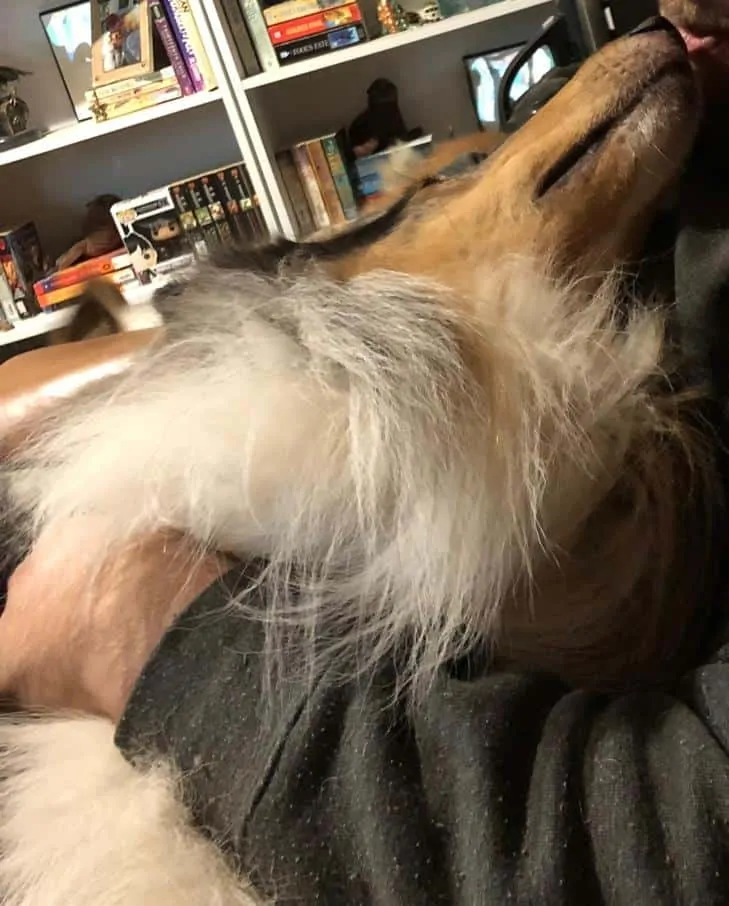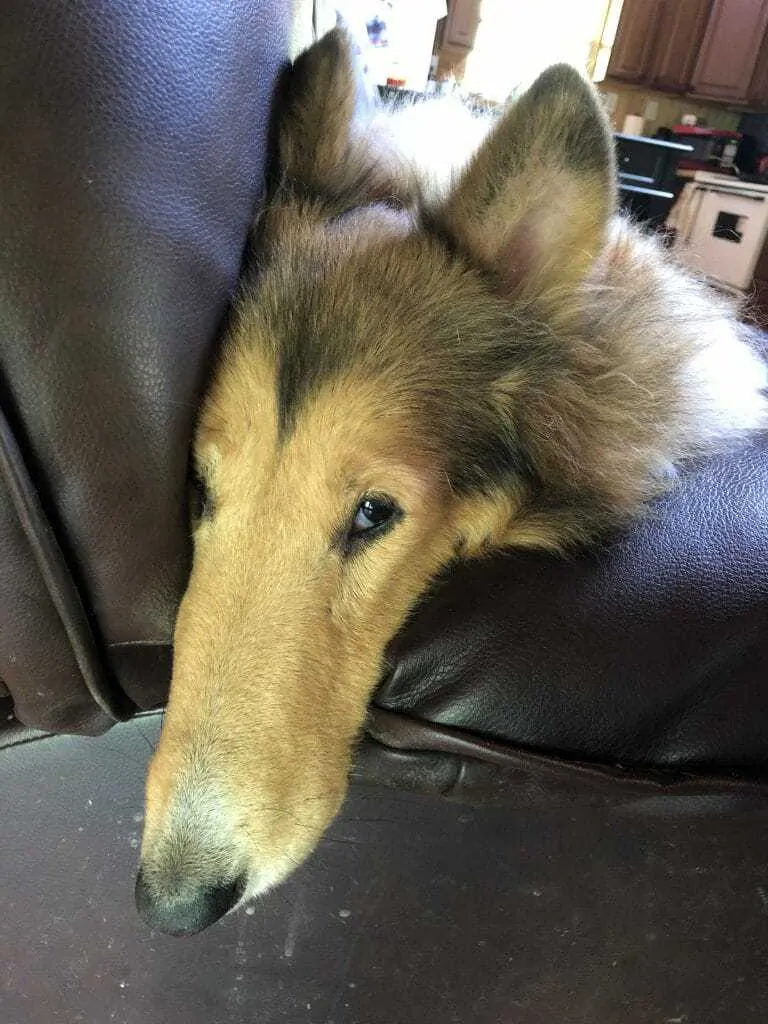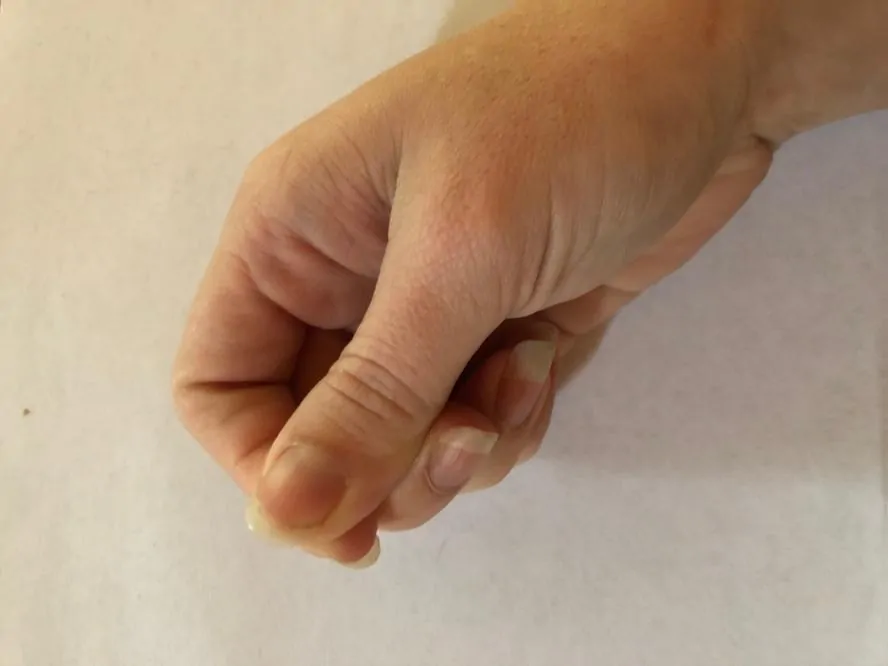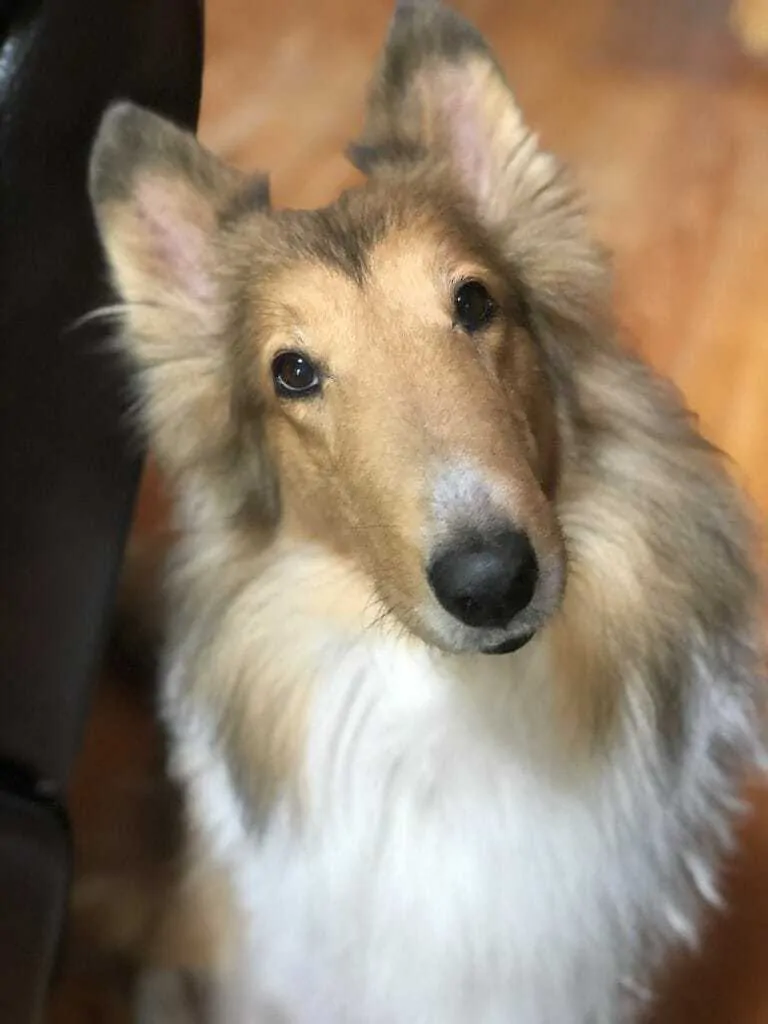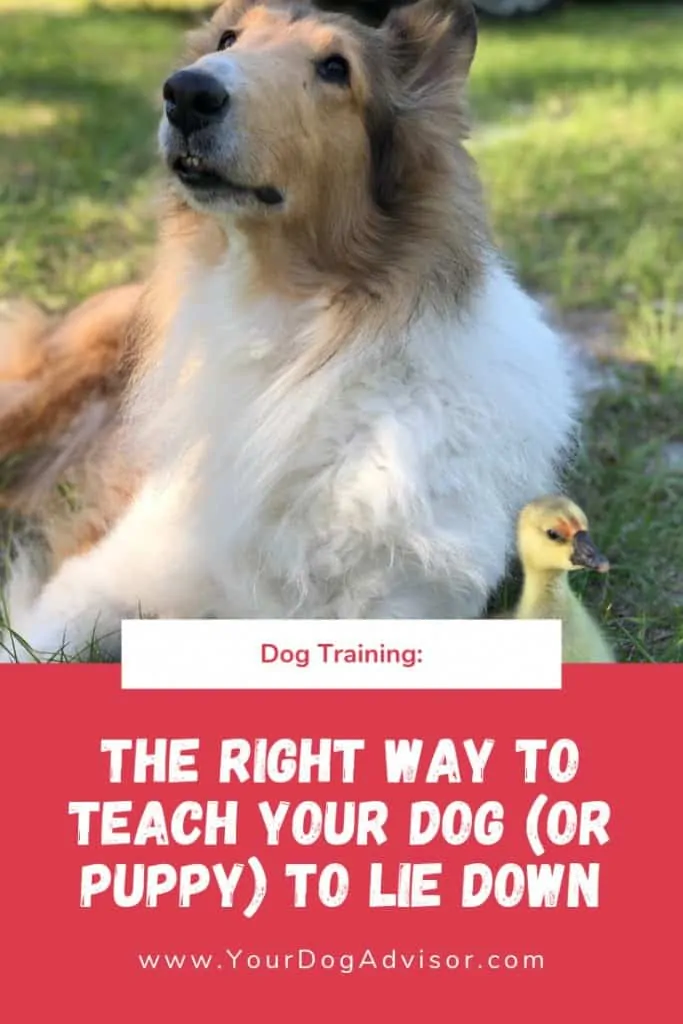As a professional dog trainer, this behavior is usually the first one I help clients fully teach a new puppy. This is typically because they have either worked on, or accidentally stumbled into, a “sit” behavior by the time I get there! While it’s all fine and dandy for your dog to guess that you want them to sit, down is a little more difficult for your dog to learn.
In fact, even with adult dog clients, I rarely meet a dog that actually knows the “down” command. Instead, they stare at you with a blank expression until you bend over or squat down and start tapping on the floor. While they do know “down,” sort of, they definitely don’t know any type of verbal command for it!
As you can see here, even young puppies learn “sit” incredibly quickly!
That brings us to the purpose of this entire piece. If you are going to teach your dog or puppy to lie down, you should do it right the first time! Together, we will walk through every step you need to know to teach your dog how to lie down the right way. However, it is easiest to train your dog to lie down if they already know “sit” on a verbal command. If they don’t please review How to Teach Your Dog to Sit the Right Way.
A good “sit” is essential to teaching your dog to lie down the right way, if a dog isn’t sitting it’s quite hard to lure them into a down! Make sure to brush up on your sit before starting your “down” command.
Contents
How Dogs Learn New Things
Before we get into the nitty gritty, it is important for you to understand a little about how animals learn. All creatures, even humans, learn the same way! If you can understand what is going into the learning process, you can understand how to teach your dog something new. One primary way that animals learn is through a process known as operant conditioning.
Operant Conditioning
When an animal learns through operant conditioning, it is learning based on the consequences of its actions. At its roots, if the animal receives a good consequence it is more likely to repeat whatever behavior it was doing. Conversely, if something bad happens that animal is less likely to repeat that behavior.
For example:
Because this dog got a treat when she rolled the ball, she is more likely to explore this object and other similar ones in the future.
The four consequences that occur are positive reinforcement, positive punishment, negative reinforcement, and negative punishment. Positive means we add something to the environment, negative means we take something away. Punishment means the animal dislikes the consequence, and reinforcement means that they enjoy the consequence.
To learn more about how operant conditioning works, click here.
However, just because a tool is available to you doesn’t mean you should use it. For our purposes, we will only use positive reinforcement when training our dogs.
Why Use Positive Reinforcement?
Though some trainers still use punishment, the vast majority of establishments now avoid punishment when training dogs. This is primarily because punishment can cause a number of unanticipated and undesired side effects when training dogs, as well as many other behavioral issues.
You see, one of the primary things that happens during operant conditioning is associations. So in our above example, the dog might associate that treat ball with good things happening. Unfortunately, when it comes down to it, it is incredibly difficult for you to predict what a dog will develop an association with.
Screenshot from the above video.
Take a look at the photo above. When you think about a dog rolling a treat ball and getting a treat, you automatically assume that the treat ball is the primary association that dog is getting. However, you should also notice from the photo that the person, and the hand, are also an important part of this interaction.
By giving the dog this treat ball, I have also created a positive association between myself and the dog. This is because I gave her an object, and something good came from it. The same goes for punishment. If I gave her the ball, and a spider leapt out and bit her, she would not only be afraid of treat balls, but also of me or of hands approaching her.
To learn more about the potential impacts punishment can have on your dog, click here.
What Kind of Reinforcement Should I Use?
Now that we know our dogs should associate us with good things happening, what type of good things should we give them for their success? There are a few factors you need to consider before you choose a reinforcement for your dog. Obviously, the most important part of finding a good reinforcer is determining what exactly your dog likes!
Dog Treats
Most dogs enjoy a good dog treat. In fact, this is typically the go-to for most people when they start training their puppy to lie down. Surprisingly, many people don’t realize that improper choice of dog treats can actually seriously impact how your dog learns.
One of the biggest mistakes that I see pet owners make is choosing dog “biscuits.” These dry, crunchy treats are pretty standard when it comes to a new puppy owner’s shopping list. The most popular kind rhymes with “bilkbone.” Don’t get me wrong, you can keep these around the house to give as the occasionally treat if you’d like. Though buyer beware, if you try to train your dog using a handful of these crispy little blocks of blandness, you’re likely to lose their attention pretty quickly.
Though dog biscuits are incredibly popular, you might find your dog growing bored when you try to train using these common treats. In fact, one of my own dogs won’t even eat them at all!
Instead of dry dog treats, which tend to bore even the most food motivated dogs, you should choose moist dog treats that you can easily break into smaller pieces. Even with the small training treats, you should break them up into smaller pieces so that your dog doesn’t fill up and lose interest.
Here are some good examples of moist or chewy dog treats that you can use for training:
No products found.
These are great small training treats, use interesting flavors like salmon and duck to keep your dog motivated.
No products found.
Flexible and soft treats are much easier for you to break into smaller pieces.
No products found.
Another great training treat to keep your dog interested.
For best results with dog treats, I like to combine several different varieties in an airtight container or Ziplock bag for training. Dogs love novelty, and when your next reinforcement tastes different from the last your dog’s motivation will continue to increase. Dogs and puppies have very short attention spans, we need every advantage we can get to keep their interest!
If you’d like to find more great training treats, see our piece on the Best Dog Treats for Training.
Toys and Games
Another great way to reward your dog for a job well done is a good game or some play with their favorite toy. Many dogs love a good game of fetch or tug, and if they love something you can definitely use it as reinforcement to teach them that they’re on the right path!
You should always make sure that you’re playing a structured game of tug or fetch with your dog. To learn how to properly play tug with your dog, see our Tug-of-War article.
Even dogs who don’t grab and rip at the tug rope can still enjoy a game of tug as their reinforcement, as you can see by this dachshund’s chasing and tail-wagging!
Attention and Affection
Some dogs aren’t quite the rambunctious type, and that’s perfectly ok! If your dog really prefers a good back scratch, or even just praise and attention, you can use that as your reinforcement too! This method is a great way to switch things up for your dog, and keep things from getting too mundane, and your dog from gaining 15 lbs. in treats.
If your dog looks at you like this, they might be a little bit of a cuddle-bug.
It is, however, important to remember that not all dogs enjoy affection, and very few enjoy hugging and other invasions of personal space. Always make sure you read your dog’s body language correctly, so that you know you’re not overstimulating them. You can brush up on your canine body language here.
Conversely, if your dog looks at you like this when you go in for a hug, they might not be feeling very cuddly.
New and Interesting Foods
The easiest way to snap a dog to attention is to toss aside the boring dog treats and grab yourself a piece of boiled chicken, a little bit of leftover lean steak or ground beef, or even a chunk of dog safe fruits and veggies. Dogs love anything new, and when you surprise them with a yummy treat that they haven’t had in a while, or maybe they haven’t ever had, they’ll definitely be excited.
Some dogs simply flip their lid for a juicy piece of strawberry!
One important thing to remember with any new food item is to feed sparingly. This is especially true with foods your dog has never had before. Some dogs do not react well to certain types of foods, and many foods are not safe for dogs. Please be sure to double check what types of foods are safe for your dog to eat and ensure that anything new you give them is small quantities.
So What’s the Best Reinforcement for My Dog?
Reinforcement isn’t exactly a science, and this choice boils down to your dog’s preferences. Preferably, you should choose all of your dog’s favorite types of reinforcement and rotate them throughout your training sessions. During a single session you can give your dog three or four types of dog treats, some back scratches, and maybe surprise them with a small piece of cheese when they make a breakthrough.
Clickers and Verbal Bridges
Training doesn’t just stop at tossing a few treats your dog’s way. One of the most impactful tools in a trainer’s arsenal is known as a bridge. You have probably seen one before and wondered what exactly it does. Whether it was the dog trainer’s clicker or the dolphin trainer’s whistle, animal trainers across the board use bridges to better communicate with their animals.
That’s right, this little guy learns new behaviors using the same positive reinforcement methods we use to teach our dogs! A dolphin trainer’s whistle is used the same way as a clicker or any other bridge.
What Exactly is a Bridge?
To put it simply, a bridge is a sound or word that lets an animal know when it is has done the correct behavior. It bridges the gap between the behavior and the reinforcement. Basically, you are telling the animal “Yes, that’s exactly what I wanted! Do that more!” without all the confusing words. Many animal trainers use clickers, whistles, and words as their bridge for their animal.
Why Use a Bridge?
Even though your dog might learn how to sit when you pop a treat in its mouth several times, adding a bridge to your training procedure makes everything go a little more smoothly. Because you are more effectively communicating with your dog, they tend to learn behaviors faster. When you use a bridge your dog also learns the behavior solidly and is less likely to forget what its learned later on down the line.
So How do I Use it?
The biggest upside to using a bridge is that it is incredibly easy to execute. You don’t need to be a master dog trainer to use a bridge the right way to train your dog or puppy to lie down. All you have to do is ask your dog for a behavior, bridge when they do the behavior, and reinforce them after. It really is that simple!
Though you can use a clicker if you’d like, this tool is much more effective for specific indoor training sessions. This is because if I am outside walking with my dog, and they see a squirrel dash into the road and they don’t chase after it, I don’t want to stand around digging in my pockets for my clicker. Instead, I want to be able to quickly let them know that their behavior was great, so I use the word “OK.”
As you can see here, even while using a clicker I continue to use my verbal bridge as well. While training you can use whichever method suits you.
You can use virtually any word you’d like, but “OK” works well because you do not say it to your dog very frequently. By using a verbal bridge, you ensure that you can let your dog know they’re fantastic no matter where you are, what you’re doing, or what’s in your hands!
How to Use Luring to Teach Your Dog Something New
Though you can use a few different methods to teach your dog new things, luring is one of the easiest and fastest methods of training your dog. Shaping is also a fun method of training, but when teaching your basics luring is the best method for most pet owners. During the process of luring, you want to go through these basic steps:
- Food Lure
- Empty Hand Lure
- Verbal Command
You start with a treat in your hand and hold it where your dog can easily smell and nibble at it, but cannot eat it. This is our “lure” and we use it to move our dog into whatever position we would like them to be in.
This is the proper placement of a food lure. The dog can see, smell, and taste, but cannot eat.
Once we can easily move our dog into the proper position, we move on to an empty hand lure. For your empty hand lure, you want to hold our hand as if it still contains food, even though it’s empty. As your dog progresses, this motion becomes your hand signal.
How to begin your empty hand lure.
The final step is adding your verbal command. You want to give your verbal command clearly, and only say it once. Make sure you wait several seconds for your dog to think about what you want, then use your empty hand lure to move them into position. This is usually the most difficult part of the process, so make sure you are patient and let your dog think about what it is you want from them.
Sometimes dogs get distracted or confused, notice if you give them time to think about your verbal command they can still successfully complete the behavior.
Steps to Teach Your Dog or Puppy to Lie Down
You now officially have all the tools you need to teach your dog new behaviors, so it’s about time we show you the right way to train your dog or puppy to lie down.
Begin with your dog in a sitting position, and slowly use a food lure to lure your dog to the ground. You should lure straight down to the ground and hold your treat there rather than pulling it forward, as this can cause the dog to stand back up.
Using a food lure to move a dog into a “down” position.
Once the dog consistently moves into a “down” position using a food lure, you can begin your empty hand lure. In the beginning, you will want to hold your hand as if there is still a treat inside, like you saw in the above section. Over time and repetition, you can turn this into a hand signal, like pointing to the ground.
This video is a great example of an empty hand lure. Watch carefully and you can see the trainer use the other hand to reinforce the dog with a treat.
The final in the right way to train your dog or puppy to lie down is teaching them the verbal command “down.” This is typically the longest step of the process, because it takes the most problem solving for your dog to work through. From a sitting position, clearly say “down” or “lie down,” whichever you prefer.
You only want to say the command once, twice at the most, and then you want to wait. You should give your dog several seconds to think about what you want. I usually recommend waiting about six or seven seconds, and then using an empty hand lure to move your dog into a “down” position. For some dogs, making the connection between the verbal command and actually laying down takes just a few tries, for others it takes several training sessions.
This video is a great example of a dog who is well trained on their basic obedience behaviors and completes them quickly on a verbal command. This is your ultimate goal with your dog.
Why Not Just Push Them Into a Down Position Yourself?
Many of my dog training clients ask me why they should lure their dog into position in the first place. Pushing down on their shoulders so they slide to the ground does work to get them into position, so why not just do that?
When you push your dog down to get them into position, there is no thought process involved with the movement. Your dog doesn’t have to think about what you want, it just moves wherever you move it. The inherent problem with this is that you are losing one of the biggest perks of dog training, the mental exercise.
Mental Exercise and Training
Animals love using their brains, and when we keep them in a household or a zoological setting, where they don’t have to fight to survive, they lose some important mental exercise. When you have to search for food, it takes a lot of brainpower and critical thinking, but your dog gets all their meals handed to them on a silver platter.
Zookeepers face the same difficulties for their animals as well, and they utilize mentally stimulating activities to keep their charges entertained, stimulated, and performing natural foraging behaviors. Pet owners should strive to meet their animal’s needs as well! Though you have many different ways to provide mental exercise for your dog, one of the all-time best methods is through positive reinforcement training.
A trainer works on behaviors with an adult male California sea lion.
This brings us back to our primary reason to not simply move your dog into whatever position you want them to be. By doing this, you remove a large majority of the mental exercise your dog gets through positive reinforcement training. By letting them work through what position you want them to be in by following a lure, you make sure your dog is using their brain as much as possible. The more mental stimulation your dog gets, the better results you will have!
What to Do When Your Dog Doesn’t Succeed
We all know that not every training session is successful, but what should you do when your dog does the wrong behavior? The answer is quite simple – nothing! If you ask your dog for a behavior and they don’t respond, simply wait a few seconds and give a second verbal command or a hand signal as your backup. If you still don’t have success, try moving to an easier behavior that your dog is more likely to respond to.
This video is a good example of what to do when a dog doesn’t respond to a command. Do not respond or react in any way, wait a second or two, and try again.
If your dog consistently refuses commands or ignores you when you call them, you might want to make sure you have phased out your treats correctly, and you are varying your reinforcement.
Phasing Out Treats
As a dog trainer, one of the most common problems I hear from pet owners is that their dog used to listen, but just doesn’t pay attention to them anymore. The reason this occurs is usually quite similar across the board.
A family gets a new puppy, showers it with attention and treats, teaches it to come when called and to sit, and then phases out the treats. Then, they only show off their dog’s behaviors every once in a while by grabbing a bag of treats and parading the dog in front of guests. When you phase out your treats and forget to reinforce periodically (and you don’t use your bridge) you end up with a dog who has no reason to listen to you anymore.
(Self-Taken) If your dog gives you this look when you call them to you or ask for a behavior, you might need to reassess your reinforcement schedule!
Reinforcement Schedules
Now you don’t want to just give your dog a treat every single time you ask them to come when called, or sit, or lie down, etc. so how should you properly phase out your treats? The answer is that you shouldn’t entirely phase them out at all!
Instead of phasing out your treats, you should develop a reinforcement schedule. Basically, you make sure that you give some type of reinforcement, be it treats, new foods, play, or affection, periodically. For example, throughout the day if I ask my dog to come when called, sit, lie down, sit, target, come when called, and go to their bed, I want to ensure I reinforce one or two behaviors. For the previous example I might reinforce the third behavior and the seventh behavior.
The easiest way to keep track of your reinforcement schedule is to take notes! Write down when you reinforce your dog and what they did, and make sure you aren’t taking too long between reinforcers.
Why You Should Teach Your Dog to Lie Down on Command
“Down” is one of the first behaviors that pet owners teach their dogs, right behind “sit.” However, some pet owners never teach their dog anything at all, or don’t teach them verbal commands. Though it doesn’t always end in disaster, this is a grave mistake for a pet owner to make, simply because their dog suffers.
Mental Stimulation
We discussed it previously, but it is incredibly important to touch on mental stimulation again. Your dog needs mental stimulation. Many of the most problematic behaviors stem from a lack of mental stimulation. This is one of the primary reasons you shouldn’t take your dog’s training lying down (pun intended.)
Training using positive reinforcement is one of the most effective ways for you to increase your dog’s mental stimulation. The process of luring a dog into position definitely gets their brain working, but the most mentally stimulating part of the process is learning the verbal command.
You see, dog’s do not naturally communicate via vocabulary. They assess one another by using body language and sounds, but your dog isn’t chatting casually with the neighbor dog through the fence about the weather. This is why it is such great mental exercise for your dog to learn a verbal command. It may seem simple to you, but it takes a lot of work for your pup to make the connection between that word you said and the motion of lying down!
When you say a command to your dog, you can see them thinking and working through what you want in their eyes and face.
Core Behaviors for Basic Obedience
Another important reason to train your dog or puppy to lie down is simply mechanics. Sure, a sit is a great way to keep your dog still for a moment, but they can simply stand right up and move on when they get distracted. This is why down is one of the core behaviors for basic obedience. A dog that is laying down is not jumping on guests, getting into your business, or snatching food off the table.
In Case of Emergency
Finally, lie down is an important behavior in an emergency situation. Like we discussed above, a dog in a down is much less likely to stand and move than a dog in a sit, simply because of the mechanics. This makes it extremely useful in dangerous situations where you do not want your dog to move, like if they are across a busy street.
Teaching your dog to listen to verbal commands, regardless of which command it is, is also important in emergency situations. If your dog is outside it is bombarded by many more sensations than you are. Both their sense of smell and their sense of hearing are more acute than our own. Basically, this means that your dog is incredibly distracted by strange smells and sounds the second you walk out the door.
If your dog is used to listening to you when you say commands, it is much easier to get their attention. However, if you rely only on a bag of treats and a hand signal to get your dog to do something, you are definitely in trouble when they yank the leash out of your hand to chase a rabbit into the woods! This is why it is so incredibly important to teach your dog verbal commands as much as possible, when you speak your dog should listen intently, treats or no!
If you want to safely work with your dog off-leash, it is essential that you teach them their basic commands on a verbal cue!

Jen Jones is a professional dog trainer and behavior specialist with more than 25 years of experience. As the founder of ‘Your Dog Advisor’ and the ‘Canine Connection’ rehabilitation center, she applies a holistic, empathetic approach, aiming to address root causes rather than merely treating symptoms.
Well known for her intuitive and compassionate approach, Jen adopts scientifically-proven, reward-based methods, encouraging positive reinforcement over punishment. Jen specializes in obedience training, behavior modification, and puppy socialization. Her innovative methods, particularly in addressing anxiety and aggression issues, have been widely recognized. Jen has worked with many of the world’s leading dog behaviorists and in her free time volunteers with local animal shelters and rescue groups.

